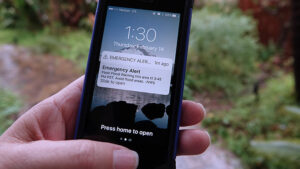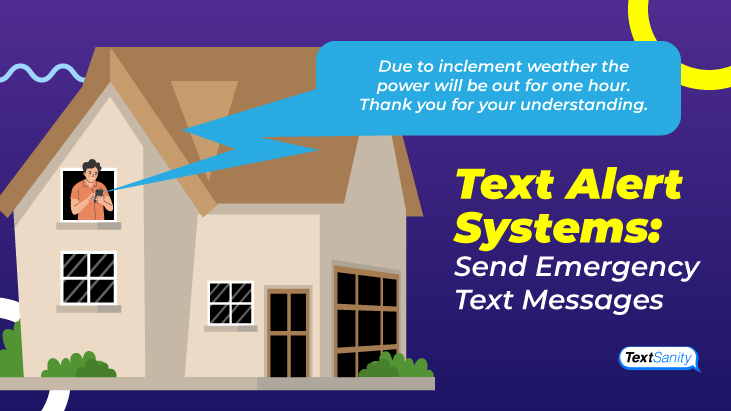Text Alert Systems: Send Emergency Text Messages
Virtually every industry uses text alert systems. In many cases, quick, short emergency text messages replace old communication styles. Bulk email campaigns or recorded phone calls to a landline are a thing of the past. When time is of the essence, as with emergencies, mass notification text alerts save lives.
Many groups use SMS platforms such as TextSanity to easily implement this highly effective mass notification system for emergencies and important updates.
Some of the groups who utilize text alerts systems include public health systems, school systems, coaches and trainers, cities, and even human resource departments. Learn more about emergency text messages and their effectiveness across industries.
 What are emergency text messages?
What are emergency text messages?
Emergency text messages are notifications sent to your cell phone, just like any other text message. These messages are sent to a group of people through an SMS platform to alert people of an emergency.
Through the text messaging platform, a keyword campaign or webform is set up to collect numbers of people who want to sign up for alerts. Once opted-in to the text marketing list, an alert can be sent immediately or scheduled through the broadcast feature.
Why use text alert systems for emergency texts?
Because Americans spend so much time on their phones, text alert systems effectively and conveniently communicate vital information in real-time. Emergency text alerts notify people where they already are — on their phones.

How to send emergency text alerts
Once you build your opted-in, text marketing contact list, create templates for your messages. Next, send text messages with only a few clicks from a computer or mobile phone through your SMS platform’s mobile app.
 Tips for sending emergency text messages
Tips for sending emergency text messages
Easily get started with a text alert program and set yourself up for success with these easy tips.
Encourage contacts to opt-in
Let people know what to expect when you ask them to sign up for emergency text alerts. You must get permission via an opt-in in order to send text alerts in a broadcast message.
Without understanding the frequency of texts or what constitutes emergency information, some users hesitate to sign up. Setting up an online, opt-in webform or keyword campaign is the first step to collecting sign ups.
Many college campuses use text alerts systems, but the opt-in rates vary. For example, Virginia Tech has nearly 100% student enrollment in emergency text alerts. It often takes just one incident — or even a false alarm — to get full buy-in for text alerts.
However, a clear communication strategy about benefits also sets group members at ease and encourages them to sign up for text alerts.
Set clear rules about when to send alerts
Establish clear-cut rules regarding what circumstances qualify as an emergency. Setting an agreed-upon list of reasons that warrant emergency text alerts vitally impacts your messages’ effectiveness.

These rules keep stakeholders calm when emergencies occur. More importantly, it eliminates any rash decisions that may be made about whether an incident warrants an emergency text alert.
Test your alert system, but not too often
You must test your alert system before an emergency occurs — not after. We recommend you test your system shortly after you set it up. Start with a small subset of group members, such as the key administrators of the emergency text alert system.
Next, perform a larger test, and choose recipients from different areas.
Finally, test the entire group to ensure the message reaches everyone. This also helps provide recipients with a “dress rehearsal” for what it looks like to receive an emergency message.
Some text alert administrators prefer to let people know a week in advance that they plan to conduct an emergency test. This helps prevent confusion and panic.
 Who can benefit from emergency text alert systems?
Who can benefit from emergency text alert systems?
Many industries use emergency text alert systems to share time-sensitive information. Below are some of the most common use cases.
Public health and safety officials
We can’t predict weather patterns, accidents on the highway, or outbreaks of a virus. Still, public health and safety officials need convenient ways to communicate important information to the community.

SMS notifications come in handy following an accident on the highway that causes serious delays. When you send a text alert, it helps reroute traffic to aid law enforcement and enables emergency personnel to get to an accident faster.
Text messages help improve and protect safety and health, as well.
For example, text alerts effectively help increase vaccinations in communities, according to public health officials. Other examples of emergency text alerts for public health and safety health include unexpected utility repairs and power outages.
School administrators
Perhaps schools benefit the most from the adoption of emergency text alerts. Schools traditionally perform emergency drills for emergencies such as fire and tornado drills. With recent events related to school violence, school administrators put safety for students, teachers, and faculty at top of mind more than ever.
Now, schools widely adopt emergency texts. Schools benefit from text emergency alerts in a variety of ways.
For example, parents, teachers, and faculty need to know as soon as possible following school delays and closures. Closing notifications help working parents quickly make arrangements for child care. Similarly, when the school must cancel events, a quick text can reroute parents already on their way home from the office.
Text alerts aid the spread of healthcare information as well. When a pink eye outbreak hits the entire fourth grade, you want to get a message out fast to parents to watch for signs. Segment your list to fourth-grade parents, and get a text out immediately.

Unfortunately, school violence occurs nationwide. When a safety issue threatens the school community, a quick emergency alert informs administrators in real time, no matter where they are in the school.
Coaches and trainers
Sports coaches lead their teams. Whether they’re coaching a middle school team, high school students, or a college-level or club team, communication vitally assists the creation of a cohesive team. It keeps all team members on the same page.
Coaches and trainers find text alerts handy for emergency and non-emergency situations, such as game cancellations, venue changes, safety situations, or pick-up times for parents.
Employers and HR departments
Employers must keep their staff members safe and informed. Old methods, like a P.A. system, an email blast, or an automated voicemail no longer suffice to communicate during an emergency situation. In fact, 91% of adults surveyed said they prefer texting to voicemail.
SMS alerts work well for employers and HR departments in building evacuations, inclement weather conditions, such as a tornado, and workplace violence issues.
How expensive are text alert systems?
Thanks to SMS platforms, text alerts systems cost-effectively address your mass notification needs.
At TextSanity, pricing varies based on your desires, from plans for small groups to enterprise-level plans for large businesses.
 Use text messaging tools to set up text alert systems
Use text messaging tools to set up text alert systems
Consider your current emergency plan at your place of business or school and the likelihood of reaching everyone with your current emergency alert system. Sometimes, a multi-faceted approach works best with both an email and an emergency text alert.

You need to be prepared to communicate critical information to groups of people quickly. Add text messaging to your existing communication plan!
How TextSanity helps
If you’re not sure exactly what your needs look like, contact TextSanity. Find the right plan that meets your needs, and let our support team help you set up your emergency text alert system.
The bottom line
Consider why schools, public officials, coaches, and HR departments adopt emergency text alerts — it effectively reaches the largest number of people. Emergency text alerts effectively, cost-efficiently, and easily help you get the message out.


